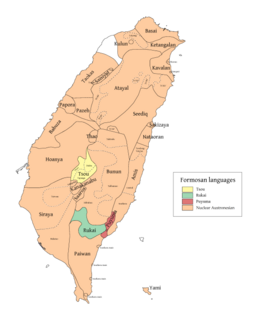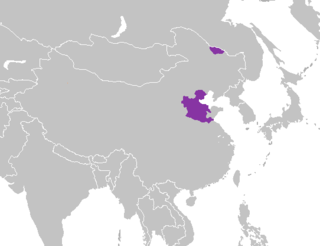Related Research Articles

Arabic is a Semitic language spoken primarily across the Arab world. Having emerged in the 1st century, it is named after the Arab people; the term "Arab" was initially used to describe those living in the Arabian Peninsula, as perceived by geographers from ancient Greece.

The Ivatan (Ibatan) language, also known as Chirin nu Ibatan, is a Philippine language of Austronesian origins spoken in the Batanes Islands of the Philippines.

Ipala is a town and municipality in the Chiquimula department of Guatemala.
The Eleme people are one of the various groups of indigenous peoples that inhabit the Niger Delta region of South-South Nigeria.
The Anêm language is a Papuan language spoken in five main villages along the northwestern coast of New Britain, Papua New Guinea.

Tsou is a divergent Austronesian language spoken by the Tsou people of Taiwan. Tsou is a threatened language; however, this status is uncertain. Its speakers are located in the west-central mountains southeast of the Chiayi/Alishan area in Taiwan.

Jilu or Ji–Lu Mandarin, formerly known as Beifang Mandarin "Northern Mandarin", is a dialect of Mandarin Chinese spoken in the Chinese provinces of Hebei (Jì) and the western part of Shandong (Lǔ) and Xunke, Tangwang & Jiayin counties of Heilongjiang. Its name is a combination of the abbreviated names of the two provinces, which derive from ancient local provinces. The names are combined as Ji–Lu Mandarin.

Volcán Ipala is a stratovolcano in south-eastern Guatemala. It has a 1,000 metres (3,300 ft) wide summit crater which contains a crater lake, whose surface lies about 150 m (500 ft) below the crater rim. Volcán Ipala is part of a cluster of small stratovolcanoes and cinder cone fields in south-eastern Guatemala.
Asa'pili is a constructed language created by Swiss author P.M. in his book Bolo'bolo. On the one hand, it is an artistic language, intended to explain his concepts for a sustainable future in an original way. On the other hand, it is a neutral auxiliary language intended for use in the quasi-utopian bolo-based global community which he describes in the book. Asa'pili is not a full language, but a basic vocabulary of about thirty words, which can be used to refer to cultural institutions and concepts.

Komki-Ipala is a department or commune of Kadiogo Province in central Burkina Faso. Its capital lies at the town of Komki-Ipala.
Ipala is a village in the Zam Department of Ganzourgou Province in central Burkina Faso. The village has a population of 824.
Ipala, Bam is a village in the Tikare Department of Bam Province in northern Burkina Faso. It has a population of 448.
Quibala is a town, with a population of 27,128, and a municipality in Cuanza Sul, Angola. The municipality has a population of 142,057 and comprises an area of 10,300 km2. It is bordered by the city of Calulo in the north, by the town of Waku-Kungo in the east, by the municipality of Ebo in the south, and in the west by the municipality of Gabela and by Porto Amboim.

Finnish is a Uralic language of the Finnic branch, spoken by the majority of the population in Finland and by ethnic Finns outside of Finland. Finnish is one of the two official languages of Finland. In Sweden, both Finnish and Meänkieli are official minority languages. The Kven language, which like Meänkieli is mutually intelligible with Finnish, is spoken in the Norwegian county Troms og Finnmark by a minority group of Finnish descent.
Kalabari is an Ijo language of Nigeria spoken in Rivers State and Bayelsa State. Its three dialects are mutually intelligible. The Kalabari dialect is one of the best-documented varieties of Ijo, and as such is frequently used as the prime example of Ijo in linguistic literature.
The Kimbundu languages are a group of Bantu languages coded Zone H.20 in Guthrie's classification. According to Nurse & Philippson (2003), they probably form a valid node, though this is still uncertain. They are:

Dupaningan Agta, or Eastern Cagayan Agta, is a language spoken by a semi-nomadic hunter-gatherer Negrito people of Cagayan and Isabela provinces in northern Luzon, Philippines. Its Yaga dialect is only partially intelligible.

Bantoanon or Asi is a regional Bisayan language spoken, along with Romblomanon and Onhan, in the province of Romblon, Philippines. Asi originated in the island of Banton, Romblon and spread to the neighboring islands of Sibale, Simara, and the towns of Odiongan and Calatrava on Tablas Island. The Asi spoken in Odiongan is called Odionganon, Calatravanhon in Calatrava, Sibalenhon in Concepcion, Simaranhon in Corcuera, and Bantoanon in Banton.
Ngoya, also known as Pala, is a newly recognized language of Angola that since ca. 2010 has been used for national radio broadcasts. It had previously been considered a dialect of Kimbundu without any linguistic evidence, and appears to be transitional between Kimbundu and Umbundu.
Read Along, formerly known as Bolo, is an Android language-learning app for children developed by Google for the Android operating system. The application was released on the Play Store on March 7, 2019. It features a character named Dia helping children learn to read through illustrated stories. It has the facility to learn English and Indian major languages i.e. Hindi, Bengali, Tamil, Telugu, Marathi and Urdu as well as Spanish and Portuguese. It basically uses text-to-speech technology, through which the character named Dia reads the story, as well as speech-to-text technology, which mechanically identifies the matches between the text and the reading of the user. The story of Chhota Bheem and Katha Kids was added in September 2019. In April 2020, a new version of the application was released. In September 2020, it added Arabic language to its language option. A web version was launched in August 2022.
References
- ↑ Bolo at Ethnologue (18th ed., 2015) (subscription required)
- ↑ Jouni Filip Maho, 2009. New Updated Guthrie List Online